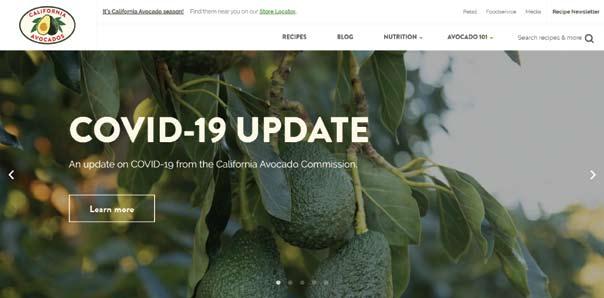
4 minute read
Message from Commission
Message from
CAC Leadership
Advertisement
John Lamb Tom Bellamore
Commission Proactively Addresses Unprecedented COVID-19 Situation
Throughout the coronavirus pandemic, the California Avocado Commission (CAC) has continuously monitored the evolving situation and made swift adjustments to its marketing plans, office operations and grower and industry communications. Well aware that COVID-19-related information would be critical to ensuring safety throughout the California avocado industry, one of the first steps the Commission took was to create a new COVID-19 resource page on the California avocado grower website. The resource page is a collection of key
government and industry guidance that includes:
• A COVID-19 industry newsfeed • Links to critical Centers for Disease Control (CDC), California of Public Health, United States Department of Agriculture (USDA), and California Department of Food and Agriculture (CDFA) COVID19 resources • Resources for agricultural employers including H-2A Visa program updates, essential worker documentation, workplace preparedness tools, guidance concerning temporary COVID-19 policies related to food safety, and economic development, loan and financial assistance resources • Families First Coronavirus Response Act fact sheets, FAQs and employee notices • Bilingual facts sheets, posters and videos that provide CDC-based guidance for agricultural workers to ensure they remain safe while at home and on the job
The Commission will continue to update the resources on the COVID19 page to capture the latest changes in legislative actions, funding opportunities and industry-related news associated with the pandemic.
To ensure safety across the entire supply chain, the Commission worked to reinforce the safe growing, harvesting and packing procedures already in place before the virus. California avocado growers and shippers continued to operate according to COVID-19
government regulations, incorporating social distancing and utilizing personal protective equipment (PPE). The Commission also provided packers with CDFA guidance on safe packinghouse procedures and information concerning PPE sources. In compliance with statewide safer-at-home orders, CAC staff began tele-working March 17.
The Commission provided feedback concerning the importance of limiting disruptions to the H-2A workforce caused by COVID-19. Upon the State Department taking steps to increase H-2A processing through consulates and expand interview waiver eligibility to help prevent delays for the workforce, the Commission shared timely updates with industry stakeholders.
The Commission also reevaluated the entirety of its marketing plans and activities, reallocating resources and adjusting its messaging, tone, timing and delivery to match the COVID-19 -related lifestyle shifts resulting from safer-at-home orders. Advertising and public relations campaigns were shifted primarily to digital platforms focused on lifestyle, food and health content, while in-person events were replaced with targeted digital alternatives. The Commission closely reviewed its messaging and realigned its consumer talking points to focus on food safety, food preservation and easy-to-prepare California avocado dishes. The Commission continues to demonstrate its leadership role in the industry, responding to media requests and engaging with peers through phone and video meetings, including participation in the Produce Marketing Association’s weekly Virtual Town Hall video conferences. For an in-depth look at the Commission’s nimble adjustments to its marketing plans, refer to Flexibility Is Key: CAC Marketing Plan Adjusted for Lifestyle and Market Conditions on page 14 of this issue.
With mid-March dine-in foodservice closures in place, California avocado distribution moved primarily to retail. In March and April retail distribution expanded beyond California as planned. During the early season, the demand for California avocados was significant for retail operations somewhat offsetting the reduced demand from the foodservice industry, which typically utilizes about 30% of the crop. Overall, avocados had a remarkably good earlyseason performance at retail, outpacing fresh fruit sales growth overall. Due to robust early-season demand —some of which could be attributed to consumer panic-buying in March — California avocado growers harvested nearly 46.7 million pounds through March 22 as compared to 5.1 million pounds for the same time last year. According to IRI data, avocado sales were up by 18.8% in the week ending April 26 while fresh fruit sales saw a 16.2% rise during that same week. An overview of California avocado retail distribution this season to date can be found on page 36 of this issue.
Cognizant of the initial drop in foodservice volume, the Commission did communicate regularly with packers about the USDA Section 32 food purchase program to purchase surplus food and distribute it to communities. Because of high retail demand, packers were able to move the majority of the California avocados and secure better prices than would most likely have been received through Section 32 purchases.
The COVID-19 situation is constantly evolving and the Commission will continue to proactively plan and adjust its communication, marketing and distribution strategies accordingly. As the season progresses, growers will be able to capitalize on a unique characteristic of the fruit — its ability to remain safely on trees — and time their harvests to optimal market and lifestyle conditions. Despite the challenges presented by the new realities of the pandemic, the California avocado market has remained remarkably resilient as consumers seek fresh, healthy, versatile, easy-to-prepare and comforting food.











